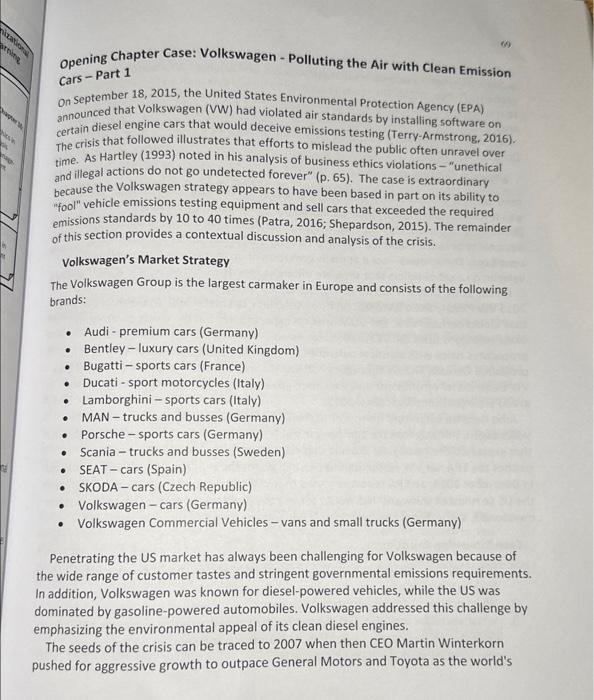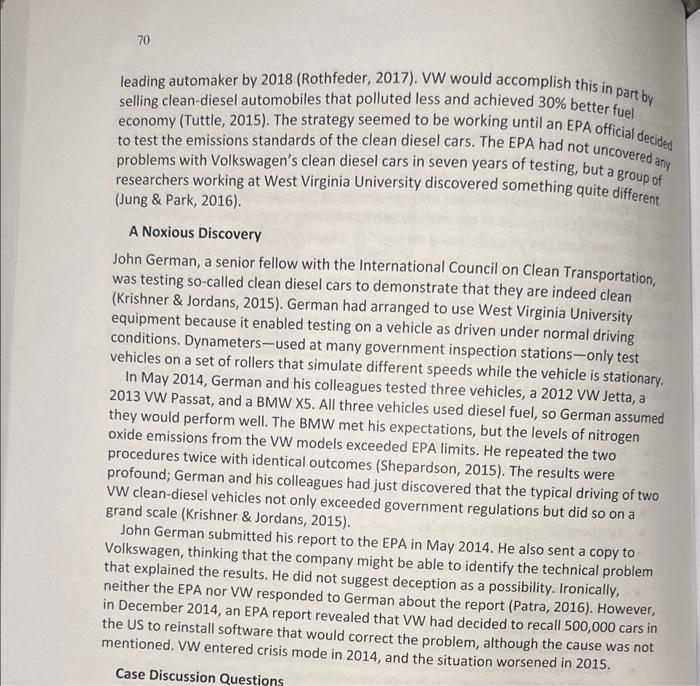Opening Chapter Case: Volkswagen-Polluting the Air with Clean Emission Cars-Part 1 On September 18, 2015, the United States Environmental Protection Agency (EPA) announced that Volkswagen (VW) had violated air standards by installing software on certain diesel engine cars that would deceive emissions testing (Terry-Armstrong. 2016). The crisis that followed illustrates that efforts to mislead the public often unravel over time. As Hartley (1993) noted in his analysis of business ethics violations - "unethical and illegal actions do not go undetected forever" (p. 65). The case is extraordinary because the Volkswagen strategy appears to have been based in part on its ability to "fool" vehicle emissions testing equipment and sell cars that exceeded the required emissions standards by 10 to 40 times (Patra, 2016; Shepardson, 2015). The remainder of this section provides a contextual discussion and analysis of the crisis. Volkswagen's Market Strategy The Volkswagen Group is the largest carmaker in Europe and consists of the following brands: - Audi-premium cars (Germany) - Bentley - luxury cars (United Kingdom) - Bugatti - sports cars (France) - Ducati-sport motorcycles (Italy) - Lamborghini-sports cars (Italy) - MAN - trucks and busses (Germany) - Porsche-sports cars (Germany) - Scania - trucks and busses (Sweden) - SEAT-cars (Spain) - SKODA - cars (Czech Republic) - Volkswagen-cars (Germany) - Volkswagen Commercial Vehicles - vans and small trucks (Germany) Penetrating the US market has always been challenging for Volkswagen because of the wide range of customer tastes and stringent governmental emissions requirements. In addition, Volkswagen was known for diesel-powered vehicles, while the US was dominated by gasoline-powered automobiles. Volkswagen addressed this challenge by emphasizing the environmental appeal of its clean diesel engines. The seeds of the crisis can be traced to 2007 when then CEO Martin Winterkorn pushed for aggressive growth to outpace General Motors and Toyota as the world's leading automaker by 2018 (Rothfeder, 2017). VW would accomplish this in part by selling clean-diesel automobiles that polluted less and achieved 30% better fuel economy (Tuttle, 2015). The strategy seemed to be working until an EPA official decided to test the emissions standards of the clean diesel cars. The EPA had not uncovered any problems with Volkswagen's clean diesel cars in seven years of testing, but a group of researchers working at West Virginia University discovered something quite different (Jung \& Park, 2016). A Noxious Discovery John German, a senior fellow with the International Council on Clean Transportation, was testing so-called clean diesel cars to demonstrate that they are indeed clean (Krishner \& Jordans, 2015). German had arranged to use West Virginia University equipment because it enabled testing on a vehicle as driven under normal driving conditions. Dynameters-used at many government inspection stations-only test vehicles on a set of rollers that simulate different speeds while the vehicle is stationary. In May 2014, German and his colleagues tested three vehicles, a 2012 VW Jetta, a 2013 VW Passat, and a BMW X5. All three vehicles used diesel fuel, so German assumed they would perform well. The BMW met his expectations, but the levels of nitrogen oxide emissions from the VW models exceeded EPA limits. He repeated the two procedures twice with identical outcomes (Shepardson, 2015). The results were profound; German and his colleagues had just discovered that the typical driving of two VW clean-diesel vehicles not only exceeded government regulations but did so on a grand scale (Krishner \& Jordans, 2015). John German submitted his report to the EPA in May 2014. He also sent a copy to Volkswagen, thinking that the company might be able to identify the technical problem that explained the results. He did not suggest deception as a possibility. Ironically, neither the EPA nor VW responded to German about the report (Patra, 2016). However, in December 2014, an EPA report revealed that VW had decided to recall 500,000 cars in the US to reinstall software that would correct the problem, although the cause was not mentioned. VW entered crisis mode in 2014, and the situation worsened in 2015. Case Discussion Questions 1. What political factors in both the United States and Europe influenced the Volkswagen crisis? 2. What economic factors impacted this case? 3. What social factors affected the automotive industry during the early 2010 s? Consider how consumers in different countries view vehicles as a means of transportation, status symbols, or both. Opening Chapter Case: Volkswagen-Polluting the Air with Clean Emission Cars-Part 1 On September 18, 2015, the United States Environmental Protection Agency (EPA) announced that Volkswagen (VW) had violated air standards by installing software on certain diesel engine cars that would deceive emissions testing (Terry-Armstrong. 2016). The crisis that followed illustrates that efforts to mislead the public often unravel over time. As Hartley (1993) noted in his analysis of business ethics violations - "unethical and illegal actions do not go undetected forever" (p. 65). The case is extraordinary because the Volkswagen strategy appears to have been based in part on its ability to "fool" vehicle emissions testing equipment and sell cars that exceeded the required emissions standards by 10 to 40 times (Patra, 2016; Shepardson, 2015). The remainder of this section provides a contextual discussion and analysis of the crisis. Volkswagen's Market Strategy The Volkswagen Group is the largest carmaker in Europe and consists of the following brands: - Audi-premium cars (Germany) - Bentley - luxury cars (United Kingdom) - Bugatti - sports cars (France) - Ducati-sport motorcycles (Italy) - Lamborghini-sports cars (Italy) - MAN - trucks and busses (Germany) - Porsche-sports cars (Germany) - Scania - trucks and busses (Sweden) - SEAT-cars (Spain) - SKODA - cars (Czech Republic) - Volkswagen-cars (Germany) - Volkswagen Commercial Vehicles - vans and small trucks (Germany) Penetrating the US market has always been challenging for Volkswagen because of the wide range of customer tastes and stringent governmental emissions requirements. In addition, Volkswagen was known for diesel-powered vehicles, while the US was dominated by gasoline-powered automobiles. Volkswagen addressed this challenge by emphasizing the environmental appeal of its clean diesel engines. The seeds of the crisis can be traced to 2007 when then CEO Martin Winterkorn pushed for aggressive growth to outpace General Motors and Toyota as the world's leading automaker by 2018 (Rothfeder, 2017). VW would accomplish this in part by selling clean-diesel automobiles that polluted less and achieved 30% better fuel economy (Tuttle, 2015). The strategy seemed to be working until an EPA official decided to test the emissions standards of the clean diesel cars. The EPA had not uncovered any problems with Volkswagen's clean diesel cars in seven years of testing, but a group of researchers working at West Virginia University discovered something quite different (Jung \& Park, 2016). A Noxious Discovery John German, a senior fellow with the International Council on Clean Transportation, was testing so-called clean diesel cars to demonstrate that they are indeed clean (Krishner \& Jordans, 2015). German had arranged to use West Virginia University equipment because it enabled testing on a vehicle as driven under normal driving conditions. Dynameters-used at many government inspection stations-only test vehicles on a set of rollers that simulate different speeds while the vehicle is stationary. In May 2014, German and his colleagues tested three vehicles, a 2012 VW Jetta, a 2013 VW Passat, and a BMW X5. All three vehicles used diesel fuel, so German assumed they would perform well. The BMW met his expectations, but the levels of nitrogen oxide emissions from the VW models exceeded EPA limits. He repeated the two procedures twice with identical outcomes (Shepardson, 2015). The results were profound; German and his colleagues had just discovered that the typical driving of two VW clean-diesel vehicles not only exceeded government regulations but did so on a grand scale (Krishner \& Jordans, 2015). John German submitted his report to the EPA in May 2014. He also sent a copy to Volkswagen, thinking that the company might be able to identify the technical problem that explained the results. He did not suggest deception as a possibility. Ironically, neither the EPA nor VW responded to German about the report (Patra, 2016). However, in December 2014, an EPA report revealed that VW had decided to recall 500,000 cars in the US to reinstall software that would correct the problem, although the cause was not mentioned. VW entered crisis mode in 2014, and the situation worsened in 2015. Case Discussion Questions 1. What political factors in both the United States and Europe influenced the Volkswagen crisis? 2. What economic factors impacted this case? 3. What social factors affected the automotive industry during the early 2010 s? Consider how consumers in different countries view vehicles as a means of transportation, status symbols, or both









